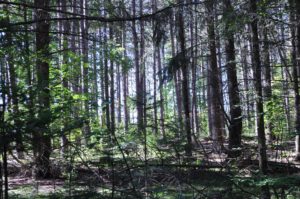 Forests in southern Ontario host much of the region’s biological diversity. They sequester carbon, which would otherwise be released into the atmosphere contributing to climate change. Forests are also part of the water cycle when transpiration from a forest’s trees moderate climate and allow efficient absorption of subsequent precipitation, reducing water flow-through rates and soil erosion. They also improve water quality, provide shade and lower water temperatures of any watercourses that pass through them. Forests can also be sources of education, recreation and biological research.
Forests in southern Ontario host much of the region’s biological diversity. They sequester carbon, which would otherwise be released into the atmosphere contributing to climate change. Forests are also part of the water cycle when transpiration from a forest’s trees moderate climate and allow efficient absorption of subsequent precipitation, reducing water flow-through rates and soil erosion. They also improve water quality, provide shade and lower water temperatures of any watercourses that pass through them. Forests can also be sources of education, recreation and biological research.
The Region of Peel’s Greenlands System classifies woodlands that are at least 16 hectares in size to be “core areas”. Only 8.5% of the Shaws Creek Subwatershed is covered by natural forests although this figure increases to 13.6% when plantations are included. Forest communities in this watershed cover 961.63 hectares. The 142 hectare Grange property hosts Shaws Creek and Orangeville branch which starts at Island Lake. These two watercourses link other parcels of forested lands, making them important corridors for the movement of wildlife.
The Alton Grange property contains a variety of woodland types, such as cultural thicket, coniferous forest (e.g. white cedar), coniferous plantation and deciduous forest (e.g. sugar maple, white ash). The coniferous plantation was planted by Mr. Granger in the 1950s. Since then succession species, such as oak trees have begun to grow in the previously planted areas.